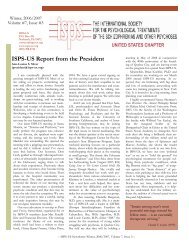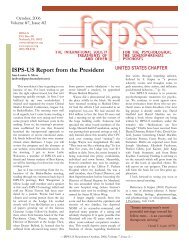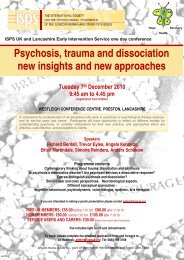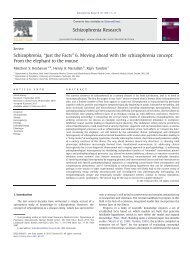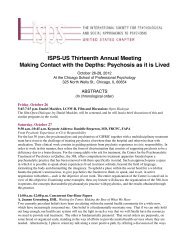Spring 2011 - ISPS-US
Spring 2011 - ISPS-US
Spring 2011 - ISPS-US
Create successful ePaper yourself
Turn your PDF publications into a flip-book with our unique Google optimized e-Paper software.
4<br />
Continued from page 3<br />
rything, "I would prefer not to." Perhaps these clients are not motivated secondary to psychotic disorders, or seriously depressed. Some,<br />
for cultural, diagnostic, or personal reasons may just not buy into the greater society's extreme emphasis on going somewhere and getting<br />
ahead. We have a commitment to these clients, while carrying the responsibility of proving that our work is justified by the standards of<br />
our overseeing bodies. Otherwise we lose the opportunity to help these vulnerable people.<br />
In this paper the presenter will report on the change at her agency from a day treatment model to a goal oriented recovery model: the<br />
PROS (Personalized Recovery Oriented Services) model being rolled out in New York State. For some clients the change will be most<br />
welcome: they have goals and are motivated. Even clients with goals which seem unrealistic to clinicians can find a place in this model.<br />
However, this paper will explore several issues which can arise when dealing with: clients who have difficulty with goal setting; clients<br />
who have given up hope and have settled for their career as a psychiatric patient; clients overwhelmed by psychotic symptoms; and a client<br />
who resembles the Scrivener himself.<br />
Hannah Starobin, LMSW and Cynthia Manson, MSW:<br />
The Therapeutic Alliance in A Social Learning Setting: The Importance of Relationship<br />
The importance of the therapeutic alliance was first recognized by Freud. Adam Phillips paraphrases Freud beautifully when he writes<br />
(1995); “people are only as mad (unintelligible) as other people are deaf (unable, or unwilling to listen)” (p.34). The path to recovery begins<br />
with the understanding of meanings and with human connection. The Second Chance Program at New York Presbyterian Hospital<br />
/ Payne Whitney Westchester is a social learning unit focused on treating individuals diagnosed with chronic treatment refractory<br />
schizophrenia. Second Chance utilizes cutting edge psychopharmacology, group and individual skills training and a token economy in a<br />
therapeutic milieu environment. It is through the simplicity of a genuine human connection and the therapeutic alliance that these often<br />
marginalized and isolated individuals once again connect to themselves and to others. With the use of two case presentations we will<br />
illustrate how the therapeutic alliance and a social learning environment work in concert to help the patient find a sense of himself, his<br />
strengths and a place in the world. In one case we will discuss the creation of a secure “holding environment” and the lending of ego<br />
strength. In a second case we will explore the use of transference and countertransference in a patient with psychogenic polydipsia.<br />
* Phillips, A. (1995). Terrors and Experts. Cambridge, MA: Harvard University Press.<br />
Kristina Muenzenmaier, MD (Chair); Mara Conan, PhD;<br />
Toshiko Kobayashi, LCAT, ATR-BC; Faye Margolis, PhD; Ekaterini Spei, PsyD:<br />
Is Treatment for Psychosis Possible in a Public Mental Health System?<br />
The panel developed out of collaboration of members of the trauma committee at a major state psychiatric hospital in New York City.<br />
The trauma committee is multi-disciplinary, multi-ethnic and includes both inpatient and outpatient staff. Committee members believe<br />
that the psychotic symptomatology of many of the patients we treat has often developed as a result of the traumatic circumstances they<br />
have faced throughout their lives.<br />
The need to cope with stress and trauma often leads to fragmentation on multiple levels. On the individual level, trauma can lead to<br />
disrupted identity development, disconnection of thoughts, feelings and behavior. On the interpersonal level, secure attachment may be<br />
disrupted and the relationships with others are often experienced as confusing and threatening.<br />
Re-traumatization often occurs when current circumstances are experienced as reenactments of the past. The external environment<br />
may be viewed as chaotic and fragmented. This fragmented world is often reenacted in the systems with which trauma survivors engage.<br />
The main goal of this panel is to discuss the presenters’ efforts to promote a multi-layered, trauma-sensitive, and integrated approach<br />
to healing within a state facility with limited resources. They will be discussing a variety of therapeutic modalities that aim at treating individuals<br />
diagnosed with serious and persistent mental illness: cognitive remediation, music and art therapy, individual and group verbal<br />
therapy. The panel will explore and discuss the collaborative aspects of the work rather than providing a detailed description of each<br />
treatment modality. They will present a case vignette to illustrate their integrative approach.<br />
Working with Psychosis at Three Developmental Stages (panel)<br />
Brenda J. Butler, MD:<br />
Enlightening the Child who Lives Inside Us: Creativity or Psychosis?<br />
Landscape designer Elizabeth Lawrence said “there is a garden in every childhood, an enchanted place where colors are brighter, the<br />
air softer, and the morning more fragrant than ever again”. Therapists have the privilege of taking a unique journey into childhood fantasy.<br />
They must balance the need to connect with and explore children’s thoughts and emotions with the expectation to diagnostically<br />
assess children. Erik Erickson’s statement “do not mistake a child for his symptom” exemplifies this conflict. Psychosis in youngsters<br />
has been a controversial topic in the field of child psychiatry. The definition of psychosis can be vague because of confusion regarding<br />
the developmentally appropriate role of imagination and fantasy. Imagination refers to the power of the mind to form images, especially<br />
those not present to the senses. Child therapists must be able to explore their own creativity, fantasy, and imagination. Bruno Bettelheim’s<br />
book, The Uses of Enchantment: The Meaning and Importance of Fairy Tales won a <strong>US</strong> Critics Choice Prize in 1976. Many psychoanalysts<br />
turned to fairy tales in an effort to understand the human mind. Workshop participants will discuss the conundrum of diagnostic clarity<br />
when discussing psychosis in children and adolescents. They will explore the importance of imagination, creativity and fantasy in the lives<br />
of children and in the development of the human mind. We’ll spend time with passages from fairy tales as part of our discussion about<br />
therapeutic alliance with children.<br />
Continued on page 5<br />
—<strong>ISPS</strong>-<strong>US</strong> Newsletter: <strong>Spring</strong>, <strong>2011</strong>, Volume 11, Issue 4—



